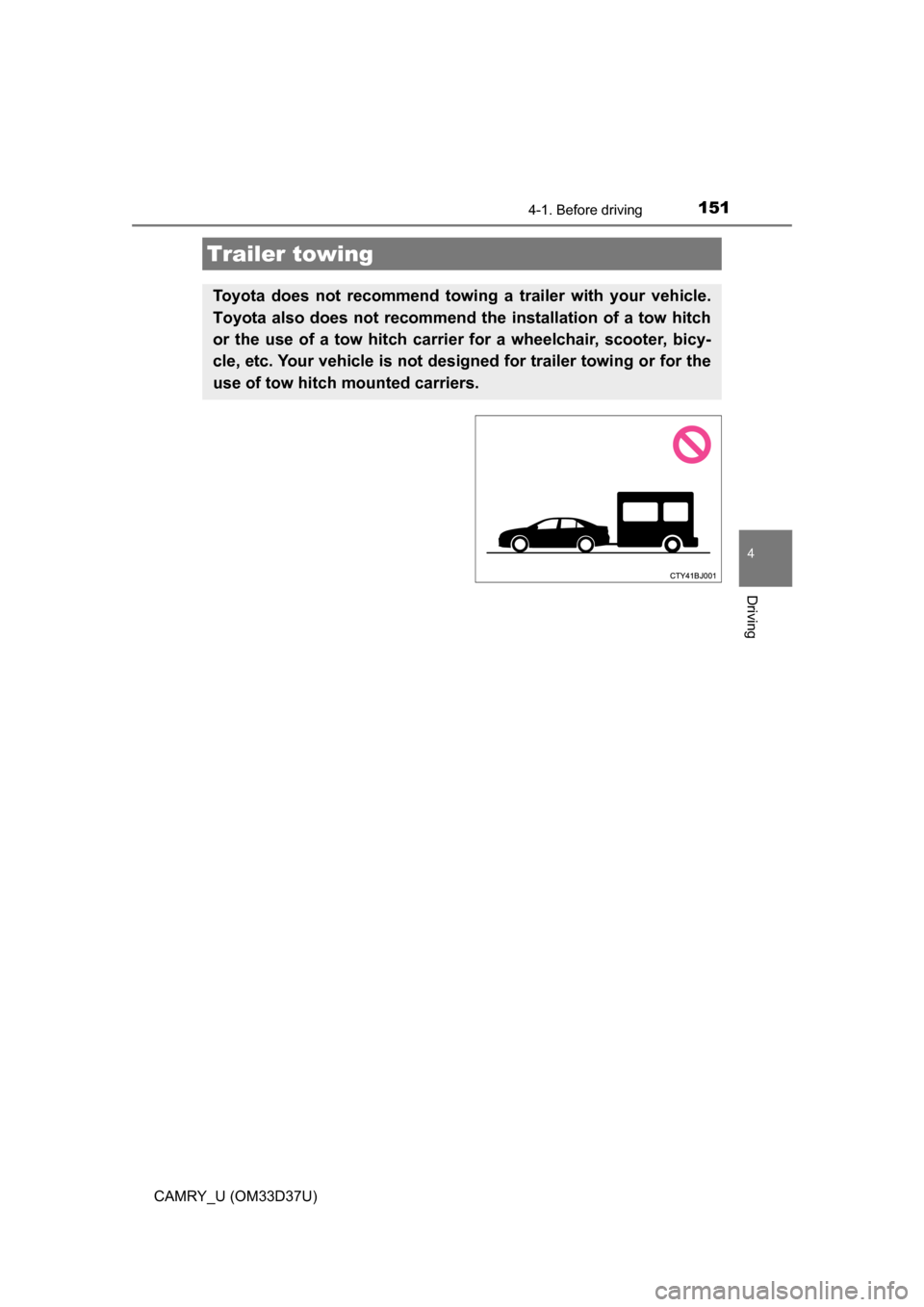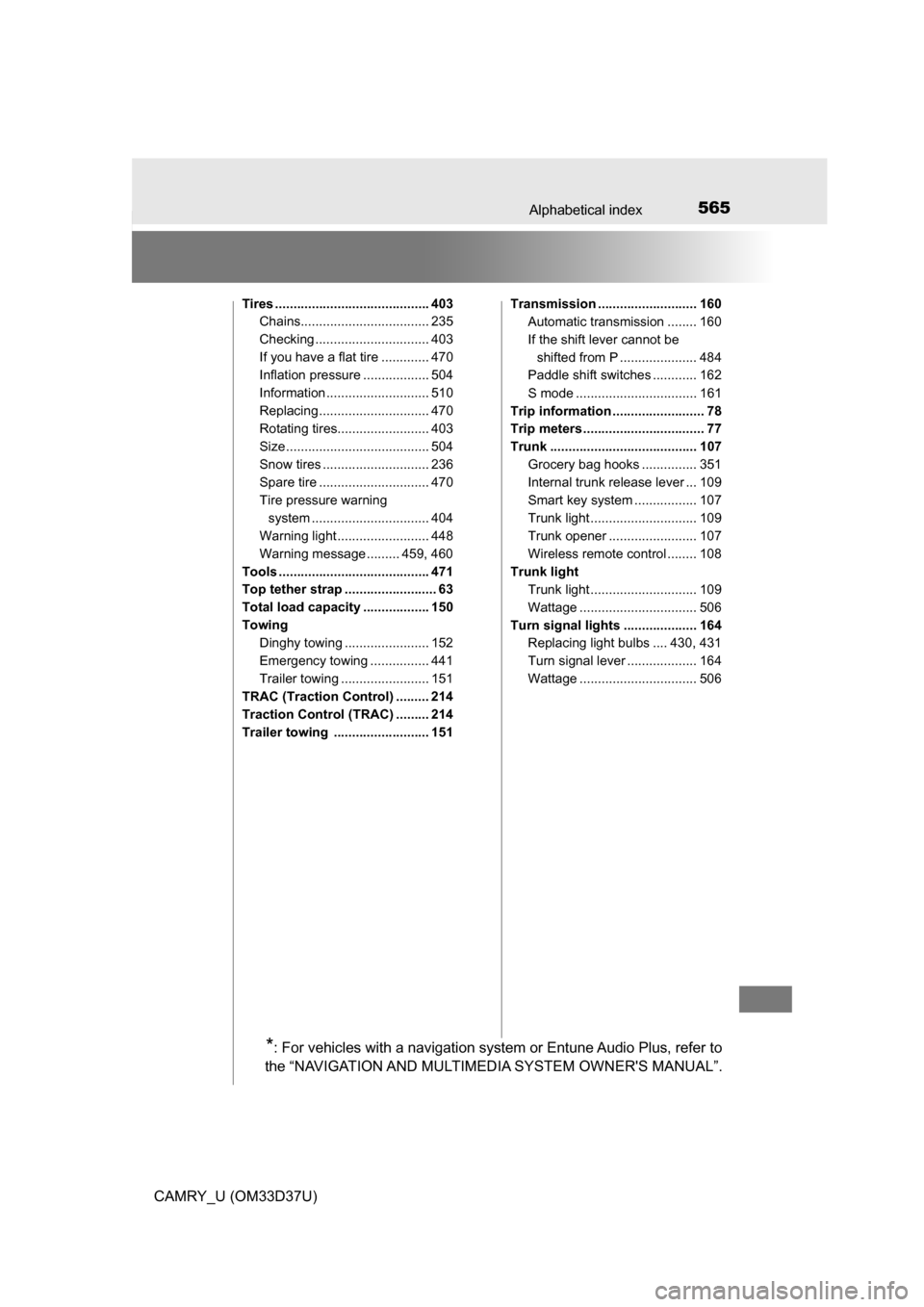2016 TOYOTA CAMRY trailer
[x] Cancel search: trailerPage 3 of 568

3
1
9 8 6 5
4
3
2
CAMRY_U (OM33D37U)
10
7
4-1. Before drivingDriving the vehicle ............. 140
Cargo and luggage............ 147
Vehicle load limits ............. 150
Trailer towing..................... 151
Dinghy towing.................... 152
4-2. Driving procedures Engine (ignition) switch (vehicles without a
smart key system) ........... 153
Engine (ignition) switch (vehicles with a smart
key system) ..................... 155
Automatic transmission ..... 160
Turn signal lever................ 164
Parking brake .................... 165
4-3. Operating the lights and wipers
Headlight switch ................ 166
Automatic High Beam ....... 170
Windshield wipers and washer ............................ 176
4-4. Refueling Opening the fuel tank cap .................................. 178 4-5. Using the driving
support systems
Cruise control .................... 181
Dynamic radar cruise control.............................. 186
LDA (Lane Departure Alert)..... 199
Rear view monitor system ............................. 205
Driving assist systems ....... 214
PCS (Pre-Collision System)..... 219
BSM (Blind Spot Monitor)......... 226
• The Blind Spot Monitor function.......................... 229
• The Rear Cross Traffic Alert function ................. 231
4-6. Driving tips Winter driving tips .............. 234
4Driving
Page 139 of 568

139
4Driving
CAMRY_U (OM33D37U)4-1. Before driving
Driving the vehicle ............. 140
Cargo and luggage ........... 147
Vehicle load limits ............. 150
Trailer towing..................... 151
Dinghy towing ................... 152
4-2. Driving procedures Engine (ignition) switch (vehicles without a
smart key system) ........... 153
Engine (ignition) switch (vehicles with a smart
key system) ..................... 155
Automatic transmission ..... 160
Turn signal lever................ 164
Parking brake .................... 165 4-3. Operating the lights and
wipers
Headlight switch ................ 166
Automatic High Beam ....... 170
Windshield wipers and washer ............................ 176
4-4. Refueling Opening the fuel tank cap .................................. 178
4-5. Using the driving support systems
Cruise control .................... 181
Dynamic radar cruise control ............................. 186
LDA (Lane Departure Alert) .... 199
Rear view monitor system ............................ 205
Driving assist systems ...... 214
PCS (Pre-Collision System) .... 219
BSM (Blind Spot Monitor) ........ 226
• T he Blind Spot
Monitor function ............ 229
• T he Rear Cross
Traffic Alert function ...... 231
4-6. Driving tips Winter driving tips ............. 234
Page 147 of 568

1474-1. Before driving
4
Driving
CAMRY_U (OM33D37U)
Cargo capacity depends on the total weight of the occupants.
(Cargo capacity) = (Total load capacity) — (Total weight of occupants)
Steps for Determining Correct Load Limit —
(1) Locate the statement “The comb ined weight of occupants and
cargo should never exceed XXX kg or XXX lbs.” on your vehicle’s
placard.
(2) Determine the combined weight of the driver and passengers that
will be riding in your vehicle.
(3) Subtract the combined weight of the driver and passengers from
XXX kg or XXX lbs.
(4) The resulting figure equals the available amount of cargo and lug- gage load capacity.
For example, if the “ XXX” amount equals 1400 lbs. and there will be
five 150 lb passengers in your v ehicle, the amount of available
cargo and luggage load capacity is 650 lbs. (1400 750 (5150) =
650 lbs.)
(5) Determine the combined weight of luggage and cargo being loaded on the vehicle. That weight ma y not safely exceed the available
cargo and luggage load capacity calculated in Step 4.
(6) If your vehicle will be towing a tr ailer, load from your trailer will be
transferred to your vehicle. Consult this manual to determine how
this reduces the available cargo and luggage load capacity of your
vehicle.
( P. 150)
Toyota does not recommend towing a trailer with your vehicle. Your
vehicle is not designed for trailer towing.
Cargo and luggage
Take notice of the following information about storage precau-
tions, cargo capacity and load:
Capacity and distribution
Page 150 of 568

1504-1. Before driving
CAMRY_U (OM33D37U)
◆Total load capacity (vehicle capacity weight): (P. 498)
Total load capacity means the comb ined weight of occupants, cargo
and luggage.
◆Seating capacity: 5 occupants (Front 2, Rear 3)
Seating capacity means the maximum number of occupants whose
estimated average weight is 150 lb. (68 kg) per person.
◆Towing capacity
Toyota does not recommend towing a trailer with your vehicle.
◆Cargo capacity
Cargo capacity may increase or decrease depending on the weight
and the number of occupants.
■Total load capacity and seating capacity
These details are also described on the tire and loading information label.
( P. 413)
Vehicle load limits
Vehicle load limits include total load capacity, seating capacity,
towing capacity and cargo capacity.
WARNING
■Overloading the vehicle
Do not overload the vehicle.
It may not only cause damage to the tires, but also degrade steering
and braking ability, resu lting in an accident.
Page 151 of 568

1514-1. Before driving
4
Driving
CAMRY_U (OM33D37U)
Trailer towing
Toyota does not recommend towing a trailer with your vehicle.
Toyota also does not recommend the installation of a tow hitch
or the use of a tow hitch carrier for a wheelchair, scooter, bicy-
cle, etc. Your vehicle is not desi gned for trailer towing or for the
use of tow hitch mounted carriers.
Page 173 of 568

1734-3. Operating the lights and wipers
4
Driving
CAMRY_U (OM33D37U)●
In the situations below, the system may not be able to correctly detect the
surrounding brightness levels, and may flash or expose nearby pedestrians
to the high beam. Therefore, you should consider turning the high beams on
or off manually rather than relying on the Automatic High Beam system.
• In bad weather (rain, snow, fog, sandstorms etc.)
• The windshield is obscured by fog, mist, ice, dirt etc.
• The windshield is cracked or damaged.
• The camera sensor is deformed or dirty.
• The camera sensor temperature is extremely high.
• Surrounding brightness levels are equal to those of headlights, tail lights
or fog lights.
• Vehicles ahead have headlights that are either switched off, dirty, are changing color, or are not aimed properly.
• The inside rear view mirror or ca mera sensor is deformed or dirty.
• When driving through an area of in termittently changing brightness and
darkness.
• When frequently and repeatedly driving ascending/descending roads, or roads with rough, bumpy or uneven surfaces (such as stone-paved
roads, gravel tracks etc.).
• When frequently and repeatedly taking curves or driving on a winding road.
• There is a highly reflective object ahead of the vehicle, such as a sign or
a mirror.
• The back of a vehicle ahead is highly reflective, such as a container on a truck.
• The vehicle’s headlights are damaged or dirty.
• The vehicle is listing or tilting, due to a flat tire, a trailer being towed etc.
• The high beam and low beam are repeatedly being switched between in an abnormal manner.
• The driver believes that the high beam may be causing problems or dis-
tress to other drivers or pedestrians nearby.
■ Temporarily lowering sensor sensitivity
The sensitivity of the sensor can be temporarily lowered.
Turn the engine switch off while the following conditions are met.
• The headlight switch is in .
• The headlight switch lever is in high beam position. Turn the engine switch to IGNITION ON mode.
Within 5 seconds after , repeat pulling the headlight switch lever to the
original position then pushing it to the high beam position quickly 9 times,
then leave the lever in high beam position.
Automatic High Beam (headlights) may turn on even the vehicle is stopped.
1
2
32
Page 196 of 568

1964-5. Using the driving support systems
CAMRY_U (OM33D37U)
WARNING
■Situations unsuitable for dynamic radar cruise control
Do not use dynamic radar cruise control in any of the following situations.
Doing so may result in inappropriate speed control and could cause an acci-
dent resulting in death or serious injury.
● Roads where there are pedestrians, cyclers, etc.
● In heavy traffic
● On roads with sharp bends
● On winding roads
● On slippery roads, such as those covered with rain, ice or snow
● On steep downhills, or where there are sudden changes between sharp up
and down gradients
Vehicle speed may exceed the set speed when driving down a steep hill.
● At entrances to expressways and highways
● When weather conditions are bad enough that they may prevent the sen-
sors from detecting correctly (fog, snow, sandstorm, heavy rain, etc.)
● When an approach warning buzzer is heard often
■ When the sensor may not be correctly detecting the vehicle ahead
In the case of the following and depending on the conditions, operate the
brake pedal when deceleration of the system is insufficient or operate the
accelerator pedal when acceleration is required.
As the sensor may not be able to correctly detect these types of vehicles,
the approach warning ( P. 191) will not be activated, which may lead to an
accident resulting in death or serious injury.
● Vehicles that cut in suddenly
● Vehicles traveling at low speeds
● Vehicles that are not moving in the same lane
● Vehicles with small rear ends (trailers with no load on board etc.)
Page 565 of 568

565Alphabetical index
CAMRY_U (OM33D37U)
Tires .......................................... 403Chains................................... 235
Checking ............................... 403
If you have a flat tire ............. 470
Inflation pressure .................. 504
Information ............................ 510
Replacing .............................. 470
Rotating tires......................... 403
Size ....................................... 504
Snow tires ............................. 236
Spare tire .............................. 470
Tire pressure warning
system ......... ....................... 404
Warning light ......................... 448
Warning message ......... 459, 460
Tools ......................................... 471
Top tether strap ......................... 63
Total load capacity .................. 150
Towing Dinghy towing ....................... 152
Emergency towing ................ 441
Trailer towing ........................ 151
TRAC (Traction Control) ......... 214
Traction Control (TRAC) ......... 214
Trailer towing .......................... 151 Transmission ........................... 160
Automatic transmission ........ 160
If the shift lever cannot be
shifted from P ..................... 484
Paddle shift switches ............ 162
S mode ................................. 161
Trip information ......................... 78
Trip meters ................................. 77
Trunk ........................................ 107 Grocery bag hooks ............... 351
Internal trunk release lever ... 109
Smart key system ................. 107
Trunk light ............................. 109
Trunk opener ........................ 107
Wireless remote control ........ 108
Trunk light Trunk light ............................. 109
Wattage ................................ 506
Turn signal lights .................... 164 Replacing light bulbs .... 430, 431
Turn signal lever ................... 164
Wattage ................................ 506
*: For vehicles with a navigation system or Entune Audio Plus, refer to
the “NAVIGATION AND MULTIMEDIA SYSTEM OWNER'S MANUAL”.